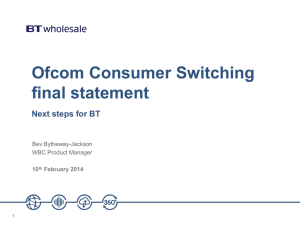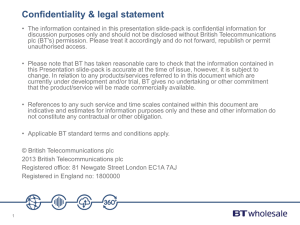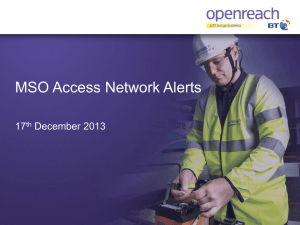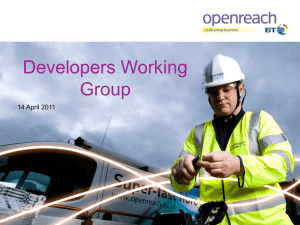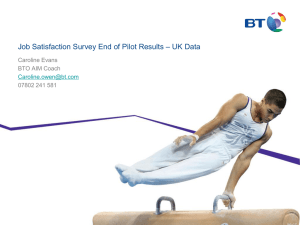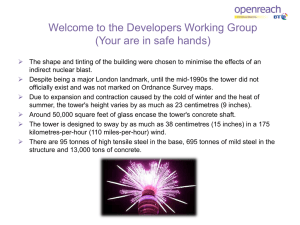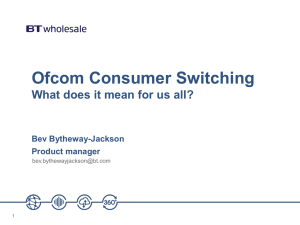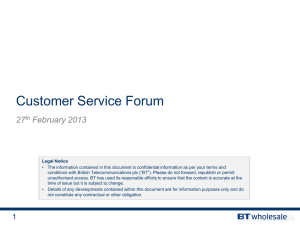WLR3 training pack
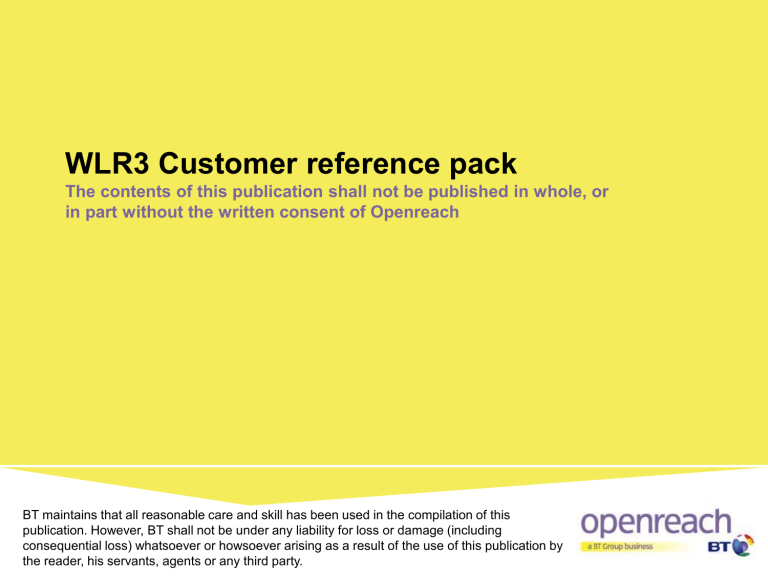
WLR3 Customer reference pack
The contents of this publication shall not be published in whole, or in part without the written consent of Openreach
BT maintains that all reasonable care and skill has been used in the compilation of this publication. However, BT shall not be under any liability for loss or damage (including consequential loss) whatsoever or howsoever arising as a result of the use of this publication by the reader, his servants, agents or any third party.
Overview of the Openreach network
The external Openreach network consists of a series of cables, wires, and fibre optic links that connect residential and business premises to the local telephone exchanges. Collectively these are known as “ lineplant ” (or the ‘access network’, or the ‘local loop’)
Currently the majority of ‘Lineplant’ is made up of metallic wires and are referred to as ‘Pairs’ as a pair of wires is required for voice / data transmission. Openreach is upgrading its network to fibre based delivery mechanisms to give higher broadband speeds as part of its next generation access rollout.
‘Pairs’ terminate at one end on an MDF (Main Distribution Frame) in the local exchange and the other end in your customer’s premises on one of a number of terminating boxes.
Pairs are linked together through a number of cross connection points as in the diagram in the following slide. At each cross connection point in the lineplant chain the two sides of a particular connection are referred to as the D-side and E-side depending on whether the direction is facing back toward the exchange (E-side) or outward to your customer and the distribution side (D Side).
General - How Service is provided.
When a new telephone service (known as a New Provide) is required at a site then a number of provision scenarios may arise.
Occasionally all the required line plant already exists and can simply be reactivated – this is a quick and simple way of providing service and is known as restarting a stopped line
In other cases spare unused ‘Pairs’ are connected together at various cross connect points to connect the site to the exchange. This is usually a straightforward installation.
In some cases brand new cable may need to be installed to enable service to be provided, this can prolong the installation lead time and increase the complexity of the order. Excess Construction Charges may apply.
WLR3 gives you much more detailed information on when and where the various scenarios above may apply, such as identifying and confirming an address and location, and identifying where spare ‘Pairs’ are already in situ at a site.
What are all the bits between the exchange and someone's house?
Main Distribution Frame
(in the exchange)
End User Premises
Pressurised Main Cable
Lead-In
Cabinet
Distribution
Point
Pillar
Underground
Distribution
Point
WLR3 Product descriptions and variants
PSTN products
WLR3 Single line basic
This is a PSTN line from the Openreach network that terminates at an End User’s Line Box. Residential and Business directory listings are available with this service.
Installation types available are :- Standard / Complex / Standard New House / Complex Hotsite
WLR3 Premium service
This is a PSTN connection from the Openreach network which terminates at either an End User’s Line Box or at a Network Test and Termination Point (NTTP). As part of the Premium PSTN Single Line service, End
Users can choose between residential and business telephone directory listings.
Installation types available are :- Standard / Complex / Standard New House / Complex Hotsite /Non served
Premise (NSP), Site / Complex Ship
WLR3 Premium Multiline aux
This terminates on either Line Boxes or NTTP equipment and provides a single phone number across a group of between 2 and 200 lines. It allows incoming calls to be routed to the first available line or to be routed cyclically using all lines in the group in turn.
Digital Products
WLR3 ISDN 2e
ISDN2e provides the equivalent of two digital telephone lines (known as channels) and is delivered over a copper pair in the public network. ISDN2e works at high speeds with good clarity for speech and data applications. ISDN2e delivers 2 x 64kbit/s ‘B’ channels and a 16 Kbit/s ‘D’ Channel for signalling
WLR3 ISDN 30
ISDN30e ETSI - European Telecommunications Standards Institute - ISDN30e is a primary rate service delivering 30x 64 kbit/s “B” channels and a 64 Kbit/s “D” channel for signalling, utilising Q931 signalling
(to the full European Standard) between the BT exchange and the Customer Premises Equipment (CPE).
ISDN30 DASS - Digital Access Signalling System - Each individual DASS bearer connection presents up to thirty 64kbit/s traffic channels over a 2Mbit/s G703 interface to the customer’s ISPBX or other equipment.
This provides digital circuit switched access to the Digital Network. The interface uses the common channel UK proprietary signalling system known as DASS 2 (Digital Access Signalling System No.2).
Some key changes to be aware of moving to WLR3
WLR3 offers much richer access to core systems and data there is a corresponding requirement for CPs to take a greater responsibility in providing and maintaining accurate data in relation to order placement of fault handling
WLR3 introduces greater variety and choice such as engineering appointments and in choosing the correct provision option when installing a new line.
WLR3 is sensitive to data accuracy and integrity. Sometimes data mismatches are encountered as legacy issues which will need to be resolved, and on other occasions they can be inadvertently introduced by CPs during the provision process, especially in the creation of address details.
LVR (Low Volume Requests) as existed in WLR2 do not exist in WLR3. Where CPs used LVRs in WLR2, they may need to change working practices in WLR3 and use a combination of multiple orders to achieve a similar outcome.
WLR ISDN products are allocated to a Service Id (depending on the charge type) rather than at the CLI level as in WLR2; this provides a unique reference number that does not change for the life of the asset and can support multiple directory numbers at that installation. The Billing User
Guide provides more detail on these changes.
WLR3 uses EMP (Equivalence Management Platform) which provides direct access to back end systems allowing CPs to work in real time data as opposed to using batch processing and buffered data as in WLR2.
The role of a TPI in WLR3.
WLR3 has been developed with a B2B interface only, i.e. messages and interaction between CPs and Openreach is achieved through sending and receiving XML code. There is no user portal provided by
Openreach on WLR3.
To access WLR3, Customers can either build their own interfaces or buy a ready made option from a TPI (Third Party Integrator).
TPIs differ in the exact products they provide but a core set of services all TPIs offer are
Portal interface and connectivity to Openreach
Support throughout set up and establishment
Training for use of TPI system
Front line customer service for TPI related issues
Product functionality scope.
WLR3 offers CPs connections from the Openreach network to terminating equipment at your customer premises. These connections support incoming and outgoing Public
Switched Telephone Network (PSTN) calls, including those routed via the BT network,
Carrier Pre-Select (CPS) or Indirect Access (IA). These are explained later in this document.
CPs can choose between single and multiline services. Single line services are available in
‘Basic’ and ‘Premium’ variants, which offer differentiated service levels. All multiline packages provide Premium service options.
The WLR3 analogue product provides CPs with a range of management tools related to:
Single and Multiline service options
WLR3 Dialogue Services
Managing Orders
Keeping Customers Informed
Service Assurance (including Care Levels)
Calling and Network Features
Route to 150, 151, 154, 156 (Route to 15x)
Social Telephony Products
Nuisance/Malicious Calls
Debt Management
Directory Entries
Call Package Selection
Billing and Payments
Complaint Handling
EMP Systems Interfaces for WLR3 – CP View
CP Systems
XML
B2B Gateway
Dialogue Services
Address Matching
Line Diagnostic Test
Appointing
Manage Line
Characteristics
Network
Availability
Number Portability
Order & Fault Status
Obtain Install
Details
CRM system
Openreach
Customer Services
Openreach systems
Billing & Payment
Workforce Mgmt
Provisioning
Assurance
WLR3 provision – L2C – Fulfilment process
» These process diagrams show the hierarchy and relationship between the various elements of the provision processes and subprocesses.
Explanation and overview of complex provision processes
For more general details on any of these processes refer to http://www.openreach.co.uk/orpg/home/products/wlr3/wlr3.do
Mergers
This enhancement allows the CP to Merge a number of WLR3
Donor installations with different products into a single ISDN2 or
PSTN target installation without a break in service. N.B. This cannot be carried out across different products
Splits
This process based solution enables the CP to manage a number of split scenarios without a significant break in service. The scenarios supported are splitting a single WLR3 ISDN2e standard or system installation into a mix of WLR3 singles lines, WLR3 multi-lines or
WLR3 ISDN2 installations with the numbers of the original installation retained.
Explanation and overview of complex provision processes
Continued.
WLTO (Working Line Take Overs)
http://www.openreach.co.uk/orpg/customerzone/products/wlr3/workinglinetakeover/business process/wltoprocessdescription.do
When an End User is moving to premises where a working line exists, the
CP can place a provision order to takeover that working line at the target premise.
WLR3 CPs have the ability to take over an MPF working line ‘with or without’ an open Stop and convert it simultaneously from MPF to a WLR3
PSTN Single line. See above link for further details on this specific function.
Partial Renumbers
This enhancement allows CPs to create or change one or more WLR3
PSTN installation(s) using details from one or more other WLR3 PSTN installation(s), but without raising multiple orders. The ‘Target’ installation(s) is(are) created or changed using details from one or more
‘Donor’ installation(s).
Directories and Phone book listings
WLR3 allows CPs to manage directory entry details for your customer. However, some aspects of directory entry management will be carried out by the Directories Team, which liaises directly with your customers, or the CP if representing them.
Basic Directory Entries
Your customer name or business name / Line Number / Installation address / Directory Location /
Directory Entry Type.
Basic Plus Directory Entries - A Basic Plus Directory Entry is available on basic and Premium lines and consists of the following information:
Your customer’s name or business name / Optional three word business description / Line
Number / Address - this may be the installation address, a partial address or a non-installation address / Directory Location, meaning the position of the entry in the phone book / Directory Entry type / Indicator that the line is a Fax or Minicom line
The Directories Team will manage all aspects of End Users’ Directory Entries. The aspects of the
Directory Entry that a CP can also manage are detailed above. The additional directory services that your customer, or CPs if representing the your customer can request from the Directories
Team (depending on the type of line) are:
Special Directory Entries (bold or superbold type)
Additional Words in the Directory Name
Additional Words in the Business Description
Multiple Directory entries
Out of Area entries
Cross Reference entries
Address Matching
This allows CPs to match your potential customer’s address details with entries in the Openreach Name and Address Database (NAD) or in the Royal Mail
Postcode and Address File (PAF). A combination of four Dialogue Services support interactive searching, unique matching of address data, and the ability to create a new address where a match cannot be found. As a result, CPs can streamline the ordering process for new lines by using addresses that
Openreach recognises.
Where a CP selects an address that matches an entry in the NAD, they are given an associated “Gold” address key. Where a CP wishes to use an address that matches an entry in PAF or an address that matches neither NAD nor PAF, they must use the “Request Address” Dialogue Service to get either a “Silver” or
“Bronze” address key respectively.
The use of address keys is mandatory for certain order types. In addition some
Dialogue Services require a “Gold” address key in order to return results.
N.B. Any address key other than Gold will drive a longer lead time (as per the orchestration matrix) to allow the address matching and survey teams to complete additional activities.
Dialogue Services used for Address Matching are:
Query Address Search
Query Address Match
Request Address
Query Address Details
Further details and the Address Matching process document is here
http://www.openreach.co.uk/orpg/customerzone/products/wlr3/pstn/businessprocess/processdescription.do
Appointing
Using a combination of three WLR3 Dialogue Services,
CPs can access appointment books and determine the availability of Openreach engineers for specific provision or repair work. In addition, they can view and reserve appointments in advance. See above link for further details on this specific function.
For more detailed reference material see link below
http://www.openreach.co.uk/orpg/customerzone/products/wlr3/pstn/bu sinessprocess/processdescription.do
Assurance - T2R - Repair
» These process diagrams show the hierarchy and relationship between the various elements of the fault management processes and subprocesses.
Registering faults - Trouble Reports
CPs may raise a Trouble Report in order to notify Openreach of a faulty service.
CPs must complete basic diagnostic tests using the “Request Test”
Dialogue Service to identify the causes of faults before raising a Trouble
Report. Depending on the results of these tests, appointments can be reserved to carry out repair work. See the Dialogue Services section earlier in this document for more information on the Request Test
Dialogue Service.
Openreach will supply a set of mandatory structured questions, which that CPs must ask to determine the nature of the fault. These questions lead to a code which describes your customer’s problem – this must be entered when a Trouble Report is raised.
When faults are resolved, Openreach will notify the CP that the fault is be cleared. It is then the responsibility of CPs to contact your customer and confirm that problems have been solved to their satisfaction. CPs then accept or reject the clear notification update. If no acknowledgment is received, the fault will close automatically and its status will be updated.
Trouble report escalation –
CPs may escalate a trouble report via EMP in a number of scenarios, the escalated Trouble Report is then put in the escalations queue within the Openreach faults team. A CP may escalate a trouble report for the following reasons:
Fault not cleared within Service Level Agreement
No response from Openreach
Appointment missed by Openreach, next available appointment is too far out
Fault resurrected, next available appointment is too far out
Task is still waiting to be issued to the Engineer
Task has been assigned to Engineer but no updates
Task has been progressed by the Engineer (i.e. engineer started work, but was unable to complete the task)
Openreach support framework –
Service based support
Customer Service Plan (CSP)
– what it is and how to use it.
The purpose of the CSPis to set out the agreed day to day working practices between Openreach and Communications Providers. In addition it will provide assistance and useful information to enable you to work with Openreach to provide the best possible service to your end users. The plan contains contact comprehensive details of the management teams responsible for service delivery of Openreach products. CSP is at the following link
http://www.openreach.co.uk/orpg/customerzone/products/customerserviceplan/cs p.do
Service Management Centre
SMC are the normal channel to support service related queries and for all cases of new order provision and fault handling. It is usual to contact the SMC after a
Siebel reference and inintial KCI is obtained as this is confirmation of acceptance of the order within the system.
Escalations
An escalation occurs where an order or fault repair has not been delivered according to the agreed timescales and requires intervention from Openreach to complete. The CP may submit an escalation request in respect of a Trouble
Report via the EMP interface (see Assurance section for more information).
For fulfilment orders the SMC should be the first point of contact. If the SMC is unable to resolve the issue an escalation reference number will be given together with direct contact with the escalations team.
Openreach support framework –
System based support
Openreach Application Support Desk.
The support desk are located in Brentwood and their role is to provide support for suspected system or IT related queries and issues. They can be contacted by email (via customer IT Zone on
Openreach portal) or directly by phone. Refer to section 8 of the above CSP for more detail and contact numbers
Bridge cases – what are they, when to raise one.
A Bridge case is an incident report used to track a suspected IT or system related issue, Bridge cases can be raised by a CP, by
Openreach or by TPIs and are given priority ratings (usually P3 for single Bridge cases) and a reference number by which to track progress.
Bridge cases should not be used for general service related problems.
WLR3 ISDN Product overview
A high-performance voice and data service for small business offices with 2 - 8 users.
ISDN2e provides the equivalent of two digital telephone lines (known as channels) and is delivered over a copper pair in the public network. ISDN works at high speeds with good clarity for speech and data applications. ISDN2e is a basic rate service delivering 2 x 64 kbit/s "B" channels and a single 16 Kbit/s "D" channel for signalling, (to the full European Standard) between the BT exchange and the Customer Premises Equipment (CPE).
ISDN30 High performance voice and data service for offices requiring eight or more lines.
ISDN30 and ISDN30e are high-performance voice and data services for modern business.
Digital technology gives you exceptional line quality.
Connections are almost instant
Voice communications with other ISDN users are crystal clear
You can send and receive calls to all telephone subscribers, whether they use digital or analogue equipment
Data transfer is fast and error free
Access to the latest digital technology with a wide range of compatible equipment
Individual Direct Dial In (DDI) numbers for your staff
Each ISDN30 connection provides between 8 and 30 independent 64k channels. You can combine these for bandwidth-hungry applications such as high-quality video conferencing or transferring large data files.
ISDN is ideal for wide-area networks linking two or more offices.
ISDN Business continuity products.
Openreach has made available to CPs a range of Business Continuity products for
WLR3 ISDN30. These products are for business end users, who require continuity to maintain their WLR3 ISDN30 telephony service in the event of a disruption or disaster.
The options are:-
Site Assurance - enables end users to have their ISDN 30 calls re-routed to an alternative site
(disaster recovery site), if their normal site becomes unusable for any reason.
Site Assurance Option 1: This option is delivered using ISDN 30 diversion services and enables all incoming calls to an end users site to be diverted to a pre-arranged single number.
Site Assurance Option 2: This option is delivered by providing a group of ISDN 30 channels to an end users standby site (disaster recovery site) these channels are enabled when required and taken out of service when not used.
Alternative Routing - Alternative routing is one method of protecting an ISDN 30 installation against cable failure, by providing ISDN 30 service via 2 separate cables from the BT local exchange to the end user premises. If one cable fails, service is maintained on the second.
Diverse Routing - Diverse Routing is an option, which protects not only against cable failure but also against the local BT exchange failing, by providing ISDN 30 from both the end user local exchange and an alternative exchange (Out of Area).
Dual Parenting - Dual Parenting is an option that enables end user DDI numbers to continue operating in the event of the end user local BT exchange failing. This is enabled by connecting the end user ISDN30 to two separate exchanges, one being the local serving exchange and the other being an alternative exchange, the alternative exchange could be OOA.
Out Of Area working (OOA) - Out of area working (OOA) provides ISDN30 service from an alternative exchange (non local) to that serving the end user, and can provide a CLI that has no association with the end user local exchange.
Battery Back Up and Stand by Power
– Stand alone power options in the event of local power failures
Excess construction charges
Excess Construction Charges (ECCs) are used in order to make it possible to extend the amount of engineering or construction that is carried out to deliver a particular service over and above the standard specification, e.g. a greater distance.
Excess charges apply to situations of extended reach, including provision to a new location within the customer's site, and can apply where existing capacity needs to be increased.
When service is requested and additional infrastructure is required or
Line Plant Rearrangement is requested, a survey will be carried out and charges will be individually assessed based upon the following elements and rates. These charges are in addition to the standard connection charges, which apply for the applicable service.
CPs should consult the price list for further information and costs for
Excess Construction.
Time Related Charges (TRCs)
TRCs cover engineering work which is not covered under the terms of a service contract with Openreach, see link below for full details of TRCs http://www.openreach.co.uk/orpg/home/products/serviceproducts/timerelatedcharges/timere latedcharges.do
For providing, repairing or rearranging network and equipment when standard
Openreach charges are not available
Your customer wants a line extended beyond the NTE at their premises
A problem is caused by wiring within your customer’s premises needs to be corrected
A problem is caused by an your customer’s faulty or incompatible equipment
An engineer undertakes work that’s out of scope of the service contract with
Openreach, or where standard charges are not available. This includes product health checks
The work needs to be carried out at specific times not covered under the terms of the standard statutory guarantee provided with line provision (e.g. during the evening or on a Sunday, when your customer only has a standard maintenance agreement)
Additional site visits
The fault is on your equipment or on end user owned/rented equipment,
TRC work is pre-authorised by the CP using a system of payment bandings conveyed to the engineers by the CP on each order.
A default banding is applied to all new provide orders of 2 hrs if no additional site visit reason has been supplied by the CP. This work will be free of charge allowing an extra socket to be provisioned up to 2 hours worth of work due to the 3m demarcation limitations
Common calling and network features explained
Outgoing Calls Barred (OCB) -This allows
End Users to bar certain types of outbound calls.
Incoming Calls Barred (ICB) This allows
End Users to bar certain types of inbound calls.
Remote call forwarding When an End User ceases service and takes up service elsewhere, or has a line renumbered, Remote Call Forward
(RCF) can be used to divert calls to an alternative number,
Call Minder - A premium voicemail feature for
WLR3 PSTN Single Line enables the CP to order
BTW Call Minder Custom and BTW Call Minder
Premium products via EMP.
Indirect Access Call Barring (IACB)is a network-based feature which rejects any outgoing call attempts by End Users keying indirect access codes.
Route to Credit Control (RTCC) – This service is a network-based feature that automatically connects End Users to CP help desks when the End User attempts to make outgoing calls and is typically used when en user credit limits have expired.
Choose to refuse is a service that enables an End User to bar the telephone number of the last answered incoming call.
Call sign End Users are provided with a second number to their existing Telephone Number. When the call sign number is dialled, the telephone connected to the line will ring with a different cadence to the normal ring tone.
Call waiting - With Call Waiting, a gentle beep during a call alerts the End User that another call is coming in.
Reminder call - An End User can, using their phone, set up a single Reminder Call or for a series of regular
Reminder Calls using the 24-hour clock.
Anonymous call rejection (ACR) is a network-based service that allows End Users to block calls from people who have withheld their numbers
Ring back - If an End User makes a call and hears an engaged tone, they can press "5" to request a Ring
Back.
Three way calling - This service allows End Users to speak to two other people at the same time even if one of them is abroad.
Call diversion - This enables the End User to have all calls diverted to another number - anywhere in the UK, most overseas destinations or to a mobile phone.
Caller redirect When an End User ceases service and takes up service elsewhere, or has a line renumbered, Caller Redirect can be used to refer callers to the new number, where the End User requests this.
Fault and Order tracker tools
Order Tracker is a self-service tool that enables CPs to proactively view the underlying Engineering Notes and SMC Notes relating to their Orders without the need to call the Openreach SMC.
The Order Tracker List View shows all Open Orders and any Orders that were
Closed within the previous 14 days.
Fault and Order tracker handbook is at the following link.
http://www.openreach.co.uk/orpg/home/products/serviceproducts/orderandfaulttrack er/orderandfaulttracker.do
Fault Tracker is a self-service tool that enables CPs to proactively view the underlying Engineering Notes and SMC Notes relating to their Faults without the need to call the Openreach SMC
.
The Fault Tracker List View shows all Open Faults and any Faults that were
Closed within the previous 14 days. It also shows any Faults that have been tagged for archive by Openreach.
The following link contains a screencast demo on using Fault Tracker
http://www.openreach.co.uk/orpg/faulttracker/FaultTrackerScreencast.html
Useful sources of reference material
XML Interface Specification
https://www.openreach.co.uk/orpg/customerzone/products/wlr3/pstn/releasedocumentation/pstnreleasedocumentation.do
Service products website
http://www.openreach.co.uk/orpg/home/products/serviceproducts/service_products.do
Response Codes
http://www.openreach.co.uk/orpg/customerzone/products/wlr3/pstn/releasedocumentation/pstnreleasedocumentation.do
Orchestration Matrix
http://www.openreach.co.uk/orpg/customerzone/products/wlr3/pstn/releasedocumentation/pstnreleasedocumentation.do
Address matching process document
http://www.openreach.co.uk/orpg/customerzone/products/wlr3/pstn/businessprocess/processdescription.do
Appointing Process document
http://www.openreach.co.uk/orpg/customerzone/products/wlr3/pstn/businessprocess/processdescription.do
Working Line Take Over process document
http://www.openreach.co.uk/orpg/customerzone/products/wlr3/workinglinetakeover/businessprocess/wltoprocessdescription.
do
WLR3 Incompatible products list
http://www.openreach.co.uk/orpg/customerzone/products/wlr3/pstn/releasedocumentation/pstnreleasedocumentation.do
WLR3 Product Swim lanes
http://www.openreach.co.uk/orpg/customerzone/products/wlr3/pstn/businessprocessmodels/pstnbpm.do
http://www.openreach.co.uk/orpg/customerzone/products/wlr3/isdn2/businessprocessmodels/isdn2bpm.do
http://www.openreach.co.uk/orpg/customerzone/products/wlr3/isdn30/businessprocessmodels/isdn30bpm.do
Price List
WLR pricing http://www.openreach.co.uk/orpg/home/products/pricing/loadProductPrices.do?data=63iUyYbpRV%2Fdw36mtxo4r1nqs1m6O cKz301sgolk8P2FdiaKKPEfrCsJCb3sZkzJ
Service Products pricing http://www.openreach.co.uk/orpg/home/products/pricing/loadProductPrices.do?data=k9c3H94HYDNSzSoB129T9Vnqs1m6Oc
Kz301sgolk8P2FdiaKKPEfrCsJCb3sZkzJ
www.openreach.co.uk
The telecommunications services described in this publication are subject to availability and may be modified from time to time.
Services and equipment are provided subject to British
Telecommunications plc’s respective standard conditions of contract. Nothing in this publication forms any part of any contract.
BT, Openreach, the BT logo and the Openreach identity are trademarks of British Telecommunications plc.
© British Telecommunications plc 2008.
Registered office: 81 Newgate Street, London EC1A 7AJ
Registered in England No: 1800000
Produced by Openreach
Designed by Westhill.co.uk
Printed in England
PHME •••••
Printed on paper which meets international environmental standards
